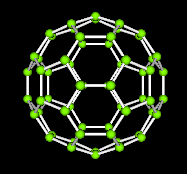| When several atoms bind together to form a molecule, the shape of the molecule depends on the way the electrons can orbit around the original atoms. Different combinations of atoms lead to differently shaped molecules. |
Carbon Nanotubes |
| When several atoms bind together to form a molecule, the shape of the molecule depends on the way the electrons can orbit around the original atoms. Different combinations of atoms lead to differently shaped molecules. |
 |
When Carbon atoms bind together, they tend to interlock in a very regular pattern, almost like Tinker Toys. For example, 60 Carbon atoms can bind together to form a spherical molecule which resembles a soccer ball. This shape is a type of "Buckyball," which gets its name from the inventor and architect Buckminster Fuller. In fact, the chemical compound C60 is called "Buckminsterfullerene." |
| Another interesting shape which can be created by joining Carbon atoms together is the "nanotube." As its name implies, a nanotube is a very, very, very small tube. In fact, the prefix "nano" means 1×10-9, or 1/1,000,000,000. So a nanotube is a tube which is just a few billionths of a meter wide. Despite its small size, a nanotube is extremely strong. Pound for pound, carbon nanotubes are hundreds of times stronger than steel cable. |
| Nanotubes also have many interesting physical and chemical characteristics. Because they are long and thin, they can act as wires; because they are hollow, they can be used as straws or pipes. They can also be closed at one or both ends, which makes it possible to use them as tiny cages, capable of trapping a single atom. |
| Scientists at MIT recently covered a flat surface with a forest of nanotubes standing side-by-side like a molecular shag carpet. This "carpet" has many interesting properties, including an amazing ability to repel water. |
| One of the most interesting implications for nanotubes comes from their possible applications in nanotechnology. Nanotechnology deals with the construction of extremely small machines, and it is one of the most fascinating fields in material research. |
| Because of their great strength
and the fact that they can be made in a wide variety of shapes, Carbon-based
nanotubes are likely to be the fundamental building blocks of nanomachines.
A team of researchers has already learned how to control a nanotube with
great precision. They were able to use a nanotube "pencil" to write
on a piece of silicon in letters just 0.250×10-9 meters
tall.
Think about this when you're preparing an equation sheet for your next test: If you could make letters this small, you could fit your entire Honors Physics course packet in a square just 1/5000 of a millimeter long on each edge. To put it another way, the period at the end of this sentence could hold about one hundred million course packets worth of notes. And that's double-spaced! |
| Of course, this wouldn't be a very practical study aid. For one thing, you would need an electron microscope just to read it. But this example does give you a sense of nanotechnology's potential for solving big problems with small machines. And these machines will almost certainly be built using Carbon nanotubes. |